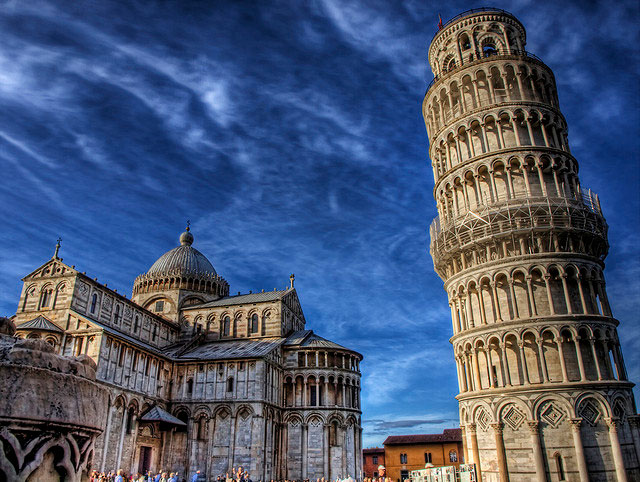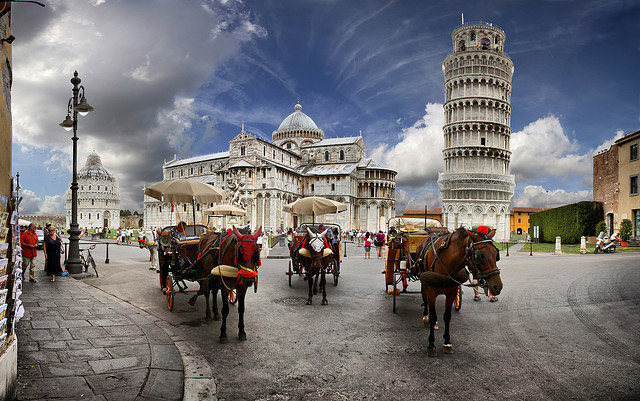Pisa leaning tower of Campo dei Miracoli
The United Nations Scientific, Educational and Cultural Organization has recognized the Campo dei Miracoli Complex, which includes Italy's Pisa leaning tower, the World Cultural Heritage in 1987.
Leaning Tower of Pisa is a famous building and also one of the seven wonders of the world. The tower is located in the Campo dei Miracoli complex, including the Duomo cathedral, Campanile bell tower, baptismal room and Camposanto cemetery. Although this whole population is recognized by Unesco as a World Cultural Heritage, in fact most people only know Pisa leaning tower . The simple reason is that this tower is so famous, not only is this tower's heritage a wonder and a pride of mankind.

First this tower is called a bell tower and was built with the aim of promoting the wealth of the city of Pisa to the world. The tower began to be constructed in 1173, but had to be stopped almost immediately after the war between Pisa and Florence. In 1180, new construction work continued and by 1185 three floors were completed. A war with Florence again occurred and money had to be prioritized for the war. During this time, the tower began to tilt, only 5cm first, and subsided from 30 to 40 cm. Until 1198, a large bell was placed on the third floor of the tower because it was originally planned to build a bell tower. However, because of the leaning tower, people used to call it the leaning tower rather than the bell tower.

The leaning tower of Pisa has a height of 567m and has a round shape, the tower body from the bottom up gradually shrinks, consisting of 6 floors in the middle are designed exactly the same. The tower floor has a diameter of 196 meters, the top diameter is 127 meters, the whole tower is estimated to have a weight of about 14,000 tons. The tower has 8 floors, the lowest floor has 15 round pillars, 6 floors in the middle of each floor has 31 round pillars, the top floor has 12 round pillars, from the 2nd floor to the 7th floor is very spacious. In the 244-step tower with spiral staircases, it is possible to circulate from the base of the tower to the top of the tower. Sculpture architecture and interior of the tower are mainly built from quartz and marble stone, a few special pillars made of diamond stone.


When standing with other buildings, the tower clearly shows its big tilt.This is the most attractive point, also the main reason for the famous tower to this day.
When the tower began to tilt, it was thought that the tower would be unusable, thus building the Duomo, Campanile bell tower, baptismal room and Camposanto cemetery next door. These four buildings form a complex called the Campo dei Miracoli . Today, if visiting the Tower of Pisa, visitors can visit all three remaining buildings.
 Buildings built next to the tower such as bell tower, cathedral, baptism room . are based on the architecture of the tower to form a uniform architectural complex.
Buildings built next to the tower such as bell tower, cathedral, baptism room . are based on the architecture of the tower to form a uniform architectural complex.
Who is the architect of Pisa tower so far is still a controversy of scientists and history. It is said that this work belongs to Bonanno Piano - a famous bronze casting that created doors for many Italian churches. It is said that Deotiusalvi - the greatest architect of the 12th century - is the father of this famous work. There are also several assumptions: Guidalotto, the builder of the German theater Maria Maria and architect Guglielmo. But all of those assumptions are not yet hypothesized enough.

Until now, after many studies of scientists and architects, the factors leading to the tilt of the tower began to be determined. The main reason is attributed to the overload pressure of the tower on the soft ground, causing the land to sink.
The time when the tower is tilted up to 90 cm, if standing below, it feels like the tower is about to collapse at any time.
In 1298, Giovanni Pisano and Orsello began to work on the refinement of the tower, when the new tower was completed with 3 floors, but after completing 3 more floors, the tower continued to be tilted. The moment the tower was most inclined, the tower had a tilt of 90cm.

Thanks to advanced scientific technology, the tower has been reduced to nearly 30 cm tilt using special straightening techniques using loads only weighing a total of 350 tons.
Scientists say the tower has been constantly tilting for the past 800 years. Although each year the tower subsided and tilted only 1ly more but it was enough to create a unique wonder in the world.
Pisa's leaning tower is famous in part because of its unique architectural design but most of the cause of fame is because it is tilted.

In the world, there is rarely any artistic work from the mistake to become a famous work, even a masterpiece like Pisa leaning tower. In 1590, the great Italian scientist Galileo Galiiei conducted a famous experiment of his movement of a free fall on the Tower of Pisa. He used two objects of different weight to drop from the top of the tower. As a result, they simultaneously landed, from that experiment he rejected the judgment of the famous Greek scientist Aristotle: " The objects have different weights, the falling speed is also different". Although unintentional, he unknowingly helped the Pisa tower become more famous.

For a long time, Pisa was recognized as the world's most tilted tower in the Guinness Book of Records . Until November 2007, the housing tower in Germany occupied the throne of Pisa tower and most recently the Capital Gate tower in the Emirate of Abu Dhabi capital has topped this list.
For many years, scientists and experts on heritage conservation have not studied the cause of the tilting of the tower while finding a solution to preserve the tower. However, this is not an easy problem because it is necessary to find a solution to maintain the leaning tower but still have to be safe for visitors.
- The cause of Pisa tower tilt
- Pisa leaning tower is gradually straightening
- Pisa Leaning Tower - Strange architecture of the world
- The secret to help the leaning tower of Pisa stand before the earthquake for 800 years
- Pisa's leaning tower has been removed
- How much is the world 'wonder' worth?
- Leaning Tower of Pisa
- Pisa's leaning tower will not fall for 300 years
- The place has just welcomed the new year 2013, escapes
- 90% of the world's population do not know the mysteries in these famous works
- B3 Cham Tower My Son cracked and tilted
- The Colosseum subsided 38cm
 Suzhou classic bonsai garden - China
Suzhou classic bonsai garden - China Chau Nguyen Dynasty
Chau Nguyen Dynasty Thai Son Mountain - World Wonder
Thai Son Mountain - World Wonder Ancient villages of Shirakawa-go and Gokayama
Ancient villages of Shirakawa-go and Gokayama